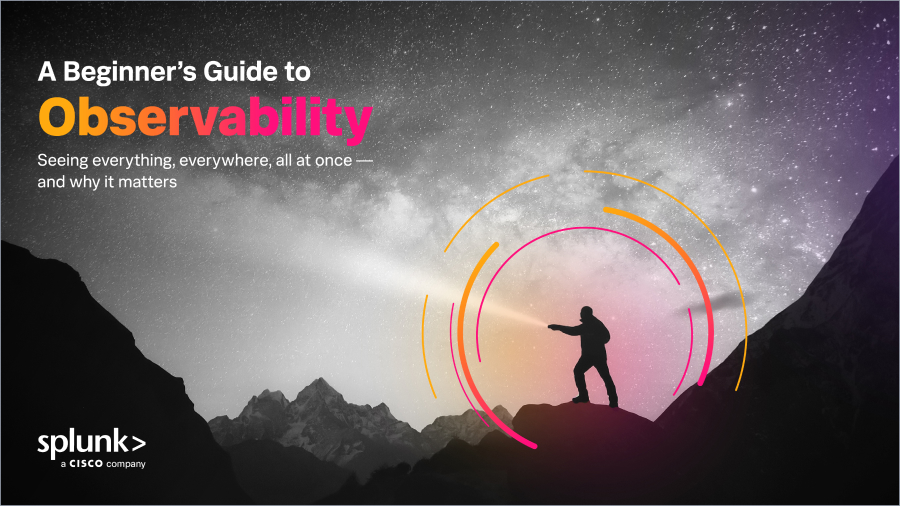Say goodbye to blind spots, guesswork, and swivel-chair monitoring. With Splunk Observability Cloud and AI Assistant, correlate all your metrics, logs, and traces automatically and in one place.
7 Strategic Benefits of Observability for Modern Enterprises
Key takeaways
- Observability empowers faster incident detection, root cause analysis, and system-wide visibility. This reduces downtime and improves reliability across complex, distributed systems.
- Mature observability practices accelerate developer productivity and deployment confidence. Teams spend less time debugging and more time shipping resilient code with real-time telemetry and automated rollbacks.
- Observability delivers strategic business value through cost optimization and user insight. By turning system data into actionable intelligence, it supports better decisions across both IT and product teams.
Your enterprise thrives on seamless digital experiences. But how do you understand the health of your systems and their direct impact on the business? Traditional monitoring falls short, too slow and fragmented to detect, diagnose, or prevent today's critical issues.
This is why observability is no longer optional. It provides the deep, holistic understanding developers, SREs, and DevOps teams need: a clear lens into performance, utilization, and direct business impact. Without this clarity, revenue is lost, and teams are stuck firefighting instead of innovating.
Discover the seven strategic benefits that make observability a game-changer for modern enterprises, delivering tangible value and competitive advantage.
Join us as we explore seven strategic benefits that demonstrate why observability is not just a technical necessity, but a critical driver for success in the modern enterprise.
Jump to a benefit:
- Detect and resolve incidents faster with real-time telemetry
- Pinpoint root causes across distributed systems
- Strengthen system reliability and prevent outages
- Boost developer productivity through real-time and deep debugging insights
- Increase DevOps agility and deployment confidence
- Turn telemetry data into business and customer insights
- Reduce costs through smarter resource monitoring
Overview: What is observability?
At its core, observability is the ability to truly understand a system's internal state by analyzing the external data it naturally produces. This deep, full-stack insight is built upon the three fundamental pillars of telemetry:
- Logs: Structured or unstructured records of discrete events
- Metrics: Numerical data over time) time (e.g., CPU usage, request rate) that can be aggregated as needed.
- Traces: Detailed flows through distributed systems).
For a deeper technical dive into these essential concepts, explore our full guide to observability and our guide to MELT: metrics, events, logs, and traces.
7 key benefits of observability
Below we break down the seven key benefits of observability in enterprise systems, from cost optimization to improved developer productivity, with examples and real-world outcomes.
Detect and resolve incidents faster with real-time telemetry
Observability enables faster incident detection by collecting real-time telemetry data (such as logs, metrics, and traces) that reveal deviations from defined norms via advanced analysis. (Analysis methods may include thresholding, statistical methods, machine learning, etc.).
Traces, in particular, can show causation. Traces map the full request flow across distributed systems, making it possible to see how problems propagate through upstream and downstream dependencies, revealing not just where an issue occurred, but why.
These analytical capabilities enable automated alerts, anomaly detection, and rapid identification of failing components, all of which contribute to:
- Lower mean time to detect (MTTD)
- Improved system uptime
Modern systems generate immense amounts of telemetry data in real time, often at sub-second granularity. Observability platforms harness this data to deliver relevant and immediate visibility into anomalies, outages, and performance issues. This empowers teams to pinpoint and resolve potential problems before they cascade into user-facing incidents. This proactive capability minimizes downtime, ensures a smoother user experience, and protects brand reputation.
Let's look at an example to see how the benefits will play out:
In a microservices architecture, if a service becomes unresponsive, observability platforms can quickly pinpoint why, whether it's due to network latency, a downstream dependency, or CPU saturation. The platform also alerts the necessary teams, captures trends, and provides historical data comparisons—all in support of faster incident resolution.
What this enables
- Early, proactive detection: Observability platforms can detect abnormal patterns in metrics or logs using methods like anomaly detection, outlier detection, and forecasting. This means teams can respond to a small issue before it escalates.
- Rapid response: Real-time insights empower teams to take immediate action, whether by notifying the right personnel or triggering automated remediation workflows. Together, early detection and fast action significantly reduces mean time to detect (MTTD).
- Minimized customer impact: The result of early detection and rapid response is fewer customer-facing errors and shorter duration of incidents, and the assurance for technical teams to act decisively, with minimal confusion or downtime.
Pinpoint root causes across distributed systems
Root cause analysis and troubleshooting in observable systems is the practice of identifying the underlying reason for system anomalies or failures through the correlation of telemetry data.
Observability supports root cause analysis and troubleshooting by providing visibility across all layers of a distributed system, allowing engineers to trace the path of a request, pinpoint errors, identify root causes through logs, and analyze related metrics.
Observability platforms provide the ability to visualize and correlate collected telemetry data, which leads to more accurate diagnostics, faster fixes, and fewer recurring incidents.
How this helps
- End-to-end tracing: Enables developers to trace a single request as it moves through services, identifying the exact service or line of code where the failure occurred.
- Context-rich logging: Structured logs with contextual metadata (e.g., user ID, request ID) help identify correlated events across services.
- Correlated views: Dashboards can show metrics, logs, and traces for a given transaction or time range, making analysis quicker and more effective.
- Centralized telemetry data: Teams no longer need to sift through disparate tooling across servers; instead, they have a centralized, correlated view.
- Reduces burnout: Centralization accelerates time to resolution, reduces engineering burnout during incidents, and improves long-term system stability by enabling comprehensive post-mortem analyses.
Strengthen system reliability and prevent outages
Observability can also improve system reliability and resilience by monitoring service-level indicators (SLIs) and tracking anomalies that can preempt outages.
With the real-time insight that observability provides, defining and tracking service-level objectives and indicators allows team to proactively address issues before they impact users.
Observability brings real-time insights into system performance and availability. This supports defining and tracking service-level objectives (SLOs) and indicators (SLIs), allowing teams to proactively address issues before they impact users. This strengthens system resilience and reduces the likelihood of SLA violations or service interruptions.
What this helps
- Service-level indicators (SLIs): Observability platforms measure SLIs such as latency, error rate, and availability, providing insights into system health.
- Proactive alerting: Teams can set thresholds that trigger alerts before SLAs are breached.
- Capacity planning: Metrics on system load and usage patterns help forecast and prevent performance degradation.
- Customer Impact: Businesses can deliver more reliable services, improving customer trust and retention.
- Strategic Advantage: Maintaining high system reliability reinforces SLAs and builds a foundation of customer confidence that directly impacts long-term revenue and brand reputation.
Boost developer productivity through real-time and deep debugging
Observability allows developers to be more productive by minimizing time spent debugging and resolving issues, thanks to clear, centralized visibility into system operations.
Developers can identify problems in real-time, understand their root causes without needing extensive knowledge sharing, and collaborate effectively with other teams via a unified observability platform.
This added visibility reduces the cognitive load on developers by making system behavior more transparent and accessible. Instead of spending hours reproducing bugs or tracing failures through multiple tools, developers can use a unified observability platform to immediately see what went wrong, where, and why.
This results in more time focused on feature development and innovation, accelerating overall development velocity (and happiness!).
Why it matters
- Faster debugging: Developers can understand issues without needing deep knowledge or manually debugging.
- Reduced context switching: Integrated observability platforms provide one place to access all telemetry data.
- Better collaboration: Shared dashboards and traces make it easier for teams across functions (Dev, Ops, QA) to collaborate.
- Better Team Efficiency: Faster development cycles, increased innovation, and higher employee satisfaction by reducing repetitive troubleshooting tasks.
Increase DevOps agility and deployment confidence
Observability strengthens DevOps and CI/CD pipelines by providing granular insights into how new code behaves in production environments. Leading observability organizations are able to:
- Detect regressions early.
- Validate performance during canary or A/B deployments.
- Automate rollbacks if necessary.
These capabilities lead to safer, faster delivery cycles, reduce the risks associated with code changes, and enable engineering teams to iterate more quickly and confidently.
What this enables
- Canary and blue/green deployments: Observability helps monitor new deployments for regressions.
- Automated rollback triggers: If error rates spike post-deployment, pipelines can be configured to rollback automatically.
- A/B testing validation: Teams can analyze performance metrics and error rates for different features.
- Business Value: Faster time-to-market, reduced release risks, and teams can iterate and experiment without fear of destabilizing production.
Turn telemetry data into business and customer insights
Observability brings in business insights from the telemetry data it tracks. This means that telemetry data is not only used for technical diagnostics but also for understanding how end users interact with software products.
System data can then be matched with business context and existing business data, such as user flows, transaction failures, and engagement metrics. This added information can be used to uncover user pain points, optimize user journeys, and align product development with customer needs and business outcomes.
Beneficial outcomes
- User journey tracing: Understand how users interact with applications and where they experience friction.
- Business KPIs via telemetry: Combine technical metrics with business context (e.g., cart abandonment rate, transaction failures).
- Customer segmentation: Observability platforms can segment performance data by customer, location, or device.
- Strategic Value: IT becomes a business enabler, not just a cost center.
Reduce costs through smarter resource monitoring
Cost optimization through observability involves leveraging system telemetry to monitor resource utilization, detect inefficiencies, and guide infrastructure decisions.
Observability platforms surface patterns in resource usage, highlight underused or overprovisioned resources, and reveal anomalies in billing or system behavior. This empowers organizations to reduce waste, better forecast capacity needs, and align infrastructure spending with actual workload demands.
It also highlights inefficiencies such as idle resources, overprovisioned systems, and costly misconfigurations.
How this helps
- Resource usage analytics: Identify underutilized services or over-provisioned resources.
- Anomaly detection in spend: Spot unusual cloud usage patterns early.
- Right-sizing: Use metrics to inform infrastructure scaling decisions.
- Efficiency Gain: Better use of cloud and hardware resources leads to lower operational costs.
- Financial Impact: Organizations can optimize their infrastructure spend, reduce unnecessary expenses, and reinvest savings into strategic innovation and growth.
Real-world example: E-commerce platform
Let's use an e-commerce site example as a reference to see how observability can impact its business. In this example, the site has experienced a sudden drop in completed checkouts and would like to check on it.
Without observability:
- Engineers check logs manually across multiple services.
- The root cause is not immediately clear.
- Recovery takes hours, causing revenue loss.
With observability:
- Traces show increased latency in the payment service.
- Logs reveal a third-party payment gateway timeout.
- An alert was triggered before the issue hit all customers.
- Engineers implement a fallback and retry mechanism and integrate it quickly.
Outcome: Faster resolution, less customer impact, more resilient architecture.
Build confidence in your complex systems
To conclude, observability empowers organizations to operate complex systems with confidence, respond to issues swiftly, understand user behavior deeply, and deliver higher-quality software at scale.
In an age where uptime, user experience, and speed of innovation are what make a competitive advantage, observability is a must. Organizations that invest in observability today are not only better equipped to handle incidents but also poised to make smarter, faster decisions across both technical and business domains.
Observability FAQs
Observability enables faster incident detection, root cause analysis, improved reliability, and cost optimization across modern systems.
It helps teams operate complex systems with confidence, reducing downtime, improving user experience, and aligning IT with business outcomes.
It offers real-time feedback during deployments, automates rollback on failure, and accelerates delivery cycles with confidence.
Yes. Observability reveals underused resources, detects billing anomalies, and guides right-sizing for optimized spending.
Developers spend less time debugging and more time building, thanks to centralized visibility, real-time data, and contextual insights.
Monitoring tells you what is wrong; observability helps you understand why it’s happening by correlating logs, metrics, and traces.
Read more on this topic >
See an error or have a suggestion? Please let us know by emailing splunkblogs@cisco.com.
This posting does not necessarily represent Splunk's position, strategies or opinion.
Related Articles
About Splunk
The world’s leading organizations rely on Splunk, a Cisco company, to continuously strengthen digital resilience with our unified security and observability platform, powered by industry-leading AI.
Our customers trust Splunk’s award-winning security and observability solutions to secure and improve the reliability of their complex digital environments, at any scale.




